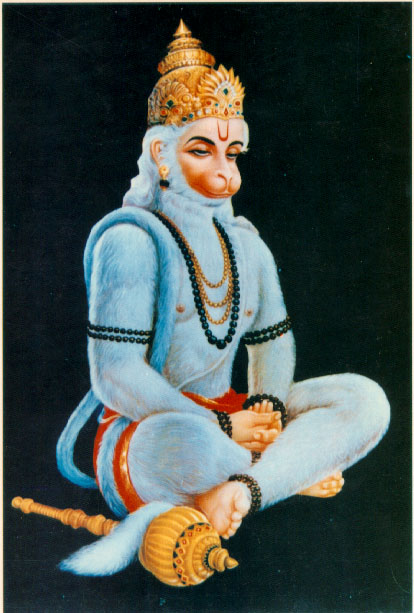
Important Days for Hanuman Swami

![]() The important days
for worshipping Hanuman Swami are Saturday, Tuesday and
Thursday. Monday is specially very good Lord Shiva.
According to a legend when Sani (Saturn) approached Hanuman
Swami to bring him under his spell, Hanuman Swami
got him by the hair , dangled him in the air and blew air on him.
Hanuman Swami let him go only after a promise from him
that he would never harm him or his devotees. For those who have Sani
the seven and a half year period as per Indian Astrology, it is
good to worship Hanuman Swami on Saturdays. Others can
worship on any of the three mentioned days to their convenience.
The important days
for worshipping Hanuman Swami are Saturday, Tuesday and
Thursday. Monday is specially very good Lord Shiva.
According to a legend when Sani (Saturn) approached Hanuman
Swami to bring him under his spell, Hanuman Swami
got him by the hair , dangled him in the air and blew air on him.
Hanuman Swami let him go only after a promise from him
that he would never harm him or his devotees. For those who have Sani
the seven and a half year period as per Indian Astrology, it is
good to worship Hanuman Swami on Saturdays. Others can
worship on any of the three mentioned days to their convenience.
Abhishekams
The significance of abhishekam to any deity is as follows:
Sandal Paste : for developing a cool mind and mental peace
Turmeric : for healing, recovery from diseases, and matrimony
Coconut : for curing asthma
Curd Rice : for curing ulcer etc
Cow’s Milk : for progeny, to ward off snake curse etc
Honey : for developing a good voice
Gold : for prosperity
Turmeric in the form of condiments is carminative, antiseptic, anti-flatulent, blood purifier and expectorant. It is used in pharmacy and confectionery. It contains carbohydrate, protein, calcium, phosphorus, iron, vitamin A, niacin, and vitamin B2.
Flowers Offered to Sri Hanuman
Garland Made of Betel Leaves
The story goes that when Sri Hanuman conveyed the message from Sri Rama, Sita Devi garlanded Sri Hanuman with a betel vine as a token of Her joy and appreciation, as she could not find any flowers nearby. Betel leaves should be made into a garland with a piece of arecanut in each leaf.
Jasmine
Anjaneya may be worshipped with jasmine flowers or tulsi on Thursdays.
Parijaatam
It is believed that Sri Hanuman prefers to frequent places where this beautiful and fragrant flower abounds.
Tulsi
Tulsi, ocimum sanctum, is a herb extensively used for worship in temples and homes. Also called Holy Basil and Hoary Basil it has several medicinal properties. Tulsi is used in temples dedicated to Lord Krishna, Sri Rama, and Sri Hanuman.
Lotus
Lotus is dear to Sri Rama. In the only temple dedicated to Bharatha, the younger brother of Sri Rama, in Irinjalakuda in Kerala too, garlands made of lotus are used. Sri Rama had equal affection for his brother Bharatha and Sri Hanuman. Lotus is also used for worship in Vishnu temples. Lord Krishna is also called the lotus eyed (Pankajaaksh).
The petals of lotus symbolise ripples on water surface representing action based on knowledge. When viewed from above, its petals would resemble the small ripples caused by throwing a stone into water. It also suggests that like lotus grown in slush, representing the mundane world, the human soul has to evolve into its eternal relation with God.
....... Maruti Pramanum by Vikraman Swamiji